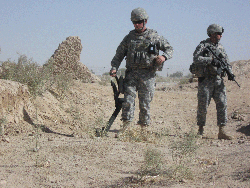New Products
Mobile Device Regional Controls
Government and private organizations face an increasing risk to their smart phones and tablet devices as employees travel around the globe. Often the cultural requirements and threats to mobile devices may differ radically in different regions of the world, and an organization’s policies might differ from one country to the next. For example, content considered acceptable in some countries is deemed highly offensive in others, and organizations may want to restrict access in areas known for industrial espionage. With GeoLocation controls added to the Mobile Enterprise Compliance and Security Server (MECS), however, the enforcement policies automatically change when arriving in a particular region. Patent-pending mobile firewall and content-filtering mechanisms enforce controls based upon the physical location of the mobile device, offering flexibility over the access rights of iPhones, iPads, smart phones and tablet devices. In addition, by restricting access to certain capabilities based upon location, MECS can save costs. MECS' GeoLocation contains three different components—the real-time map, geolocation rule base option and reporting.
Trusted Network Environment v.10
Recently approved by the Unified Cross Domain Management Office, the latest version of the General Dynamics Trusted Network Environment (TNE) suite of cross-domain, information-sharing software tools is now available for customers, including the U.S. Defense Department and intelligence communities, as well as international users. Among the upgrades, TNE 10 delivers Microsoft Office and also transitions users from the Solaris 8 to the Solaris 10 operating system. Based on the user’s profile, TNE 10 accesses, creates, combines and exchanges various levels of classified information, including e-mail, without having to physically move from one secure networked computer system to another. TNE 10 provides the computing capabilities currently available on existing TNE systems as well as operational upgrades including: built-in privilege and audit manager security controls that automatically identify users and their unique access rights; trusted regrade services enabling the transfer of data between secure networks; thin-client access; multilevel, secure Web servers, which permit users to see only the information via the Web that suits their security level; and multilevel chat, permitting individuals on different networks at different security levels to share the same chat room.
Lightweight Explosives Detector
 |
Sensor Modeling and Simulation
Newly introduced commercial modeling and simulation software is specifically designed for electro-optical infrared (EOIR) sensors used in space surveillance, missile defense and Earth remote sensing. Developed for use with AGI’s STK analysis and visualization software, STK/EOIR models sensor detection, tracking and imaging capabilities. It allows users with a basic understanding of system-level sensor specifications to improve their STK mission model with radiometric performance prediction. STK/EOIR gives systems engineers access to radiometric performance models with a level of detail matched to their needs. It also complements sensors engineers’ complex models by serving as a fast, accurate screening tool for trade studies, and it integrates sensor and mission modeling in one package, helping engineers quickly arrive at optimal system designs.
To suggest items for the New Products column, please contact: gseffers@afcea.org.




Comments